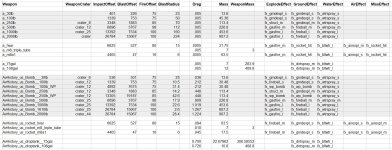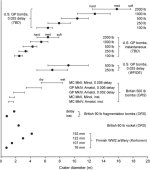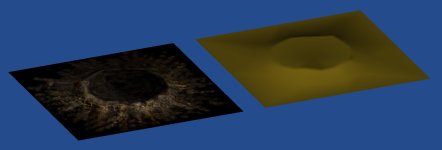Frosty
SOH-CM-2022
Unfortunately, new weapons lead to new questions: I'd like to make the in-game damage effects of the weapon models shown in the P-47 development thread (https://www.sim-outhouse.com/sohfor...gress-Thread?p=1325166&viewfull=1#post1325166) of at least similar quality as the AvHistory ones in ETO v1.50. Most of the weapon .xpd values are selfexplanatory or are sufficiently described in the CFS3 SDK. However, when it comes to what I think are the most important values, I am left with a lot of questions. For study and comparison purposes I have tabulated the most enigmatic values for a few ETO weapons (please ignore the VFX columns - I wanted to compare what weapon uses which FX to find a more consistent setup):

A few things in this table caught my attention:
- I would have thought that in ETO the 'stock' weapons (those with the "a_" prefix) would have been upgraded to AvHistory standards but apparently they are not when it comes to the "drag" value: Most are the same while the frontal areas or sizes of the weapons clearly aren't. Does anyone know/remember what the reason for this is?
- The weight values for the 'a_hvar' and 'a_m8a1' rockets are clearly wrong: The HVAR was way bigger and heavier than the M8A1. The AvHistory values are much more realistic.
- The "AvHistory_us_Bomb_1610lb" is an AP bomb. I suppose that it therefore has that very small blast radius compared to bombs of similar weight: It penetrates before exploding.
- The two AvHistory WP bombs have very large "ImpactOffset" and "BlastOffset" values but a relatively low one for "FireOffset" when compared to their GP counterparts. For a white phosphorus bomb I would have expected that to be reversed or at least show a higher value for "FireOffset", given a WP bomb's capability as an incendiary. But perhaps I misunderstand the use/effect of a WP bomb or the particular type depicted in ETO (one of my newly modeled weapons is a smoke bomb with WP as a major component). However, the VFX of the WP bombs in ETO are those of a classic WP bomb with white, smokey particle trails.
After thinking these values over, I am left with the following questions on
Offset values:
Q1a: Are the values under the "ImpactOffset", "BlastOffset" and "FireOffset" entries the actual damage(points) that the weapons inflict on other sim objects?
Q1b: If so, how are these values calculated/determined? Is there a general formula, spreadsheet etc. of any kind that would give consistent and reliable values?
Q1c: Comparing weapons of similar weight give different values for the three '-Offset' entries, as noted in the observations above. Is there a way to include real-life, known values (such as the type of explosive or the bomb's charge/total weight ratio) in the calculations?
"Drag" values :
Q2a: How is the drag coefficient of a weapon calculated in CFS3?
Q2b: Given that AvHistory internal weapons have a drag value of "0", is drag only used to influence aircraft flight behaviour or does it also influence the weapon's trajectory when dropped? (Which would make the zero drag weapons rather odd, so I guess not. Or they could be one of the many compromises necessary to make things work, given CFS3's half-baked state when published).
"Mass" values:
Q3a: Weapons labeled as 'containers' (eg. the triple rocket launcher) have two 'mass' values in their .xpds: "Mass" and "WeaponMass". I suppose the first value is the weight of the empty container and the second is the weight of the actual rockets or bombs?
Q3b: If so, is the "WeaponMass" the weight value of a single rocket/bomb or the weight of the total number of weapons in the container (so in case of the triple rocket launcher, 3x the weight of a single rocket)?
Q3c: "Mass" and "WeaponMass" can also be found in drop tank .xpd files. In this case the "WeaponMass" would be the weight of the fuel?
Considering the 'mass' values for the drop tanks, I am inclined to the idea of "WeaponMass" being the total weight of the container's contents (whether fuel, rockets or bombs) but those for both triple rocket launchers in the table are totally weird and completely off when compared to the values of the rocket .xpd (or their real-world counterparts), hence my confusion.
Decals:
Q4a: "WeaponCrater": Is this a floating point value (in meters) with the decal .dds as a prefix (eg. "crater_12")? There's only a single "crater.dds" in the "effects" folder. In the SDK there is mentioning of a "Radius" entry with a somewhat similar description.
So if anyone can shed some light on any of these questions, I am all ears! (Anyone of the old ETO crew that worked on the weapons around?)
Many thanks!!

A few things in this table caught my attention:
- I would have thought that in ETO the 'stock' weapons (those with the "a_" prefix) would have been upgraded to AvHistory standards but apparently they are not when it comes to the "drag" value: Most are the same while the frontal areas or sizes of the weapons clearly aren't. Does anyone know/remember what the reason for this is?
- The weight values for the 'a_hvar' and 'a_m8a1' rockets are clearly wrong: The HVAR was way bigger and heavier than the M8A1. The AvHistory values are much more realistic.
- The "AvHistory_us_Bomb_1610lb" is an AP bomb. I suppose that it therefore has that very small blast radius compared to bombs of similar weight: It penetrates before exploding.
- The two AvHistory WP bombs have very large "ImpactOffset" and "BlastOffset" values but a relatively low one for "FireOffset" when compared to their GP counterparts. For a white phosphorus bomb I would have expected that to be reversed or at least show a higher value for "FireOffset", given a WP bomb's capability as an incendiary. But perhaps I misunderstand the use/effect of a WP bomb or the particular type depicted in ETO (one of my newly modeled weapons is a smoke bomb with WP as a major component). However, the VFX of the WP bombs in ETO are those of a classic WP bomb with white, smokey particle trails.
After thinking these values over, I am left with the following questions on
Offset values:
Q1a: Are the values under the "ImpactOffset", "BlastOffset" and "FireOffset" entries the actual damage(points) that the weapons inflict on other sim objects?
Q1b: If so, how are these values calculated/determined? Is there a general formula, spreadsheet etc. of any kind that would give consistent and reliable values?
Q1c: Comparing weapons of similar weight give different values for the three '-Offset' entries, as noted in the observations above. Is there a way to include real-life, known values (such as the type of explosive or the bomb's charge/total weight ratio) in the calculations?
"Drag" values :
Q2a: How is the drag coefficient of a weapon calculated in CFS3?
Q2b: Given that AvHistory internal weapons have a drag value of "0", is drag only used to influence aircraft flight behaviour or does it also influence the weapon's trajectory when dropped? (Which would make the zero drag weapons rather odd, so I guess not. Or they could be one of the many compromises necessary to make things work, given CFS3's half-baked state when published).
"Mass" values:
Q3a: Weapons labeled as 'containers' (eg. the triple rocket launcher) have two 'mass' values in their .xpds: "Mass" and "WeaponMass". I suppose the first value is the weight of the empty container and the second is the weight of the actual rockets or bombs?
Q3b: If so, is the "WeaponMass" the weight value of a single rocket/bomb or the weight of the total number of weapons in the container (so in case of the triple rocket launcher, 3x the weight of a single rocket)?
Q3c: "Mass" and "WeaponMass" can also be found in drop tank .xpd files. In this case the "WeaponMass" would be the weight of the fuel?
Considering the 'mass' values for the drop tanks, I am inclined to the idea of "WeaponMass" being the total weight of the container's contents (whether fuel, rockets or bombs) but those for both triple rocket launchers in the table are totally weird and completely off when compared to the values of the rocket .xpd (or their real-world counterparts), hence my confusion.
Decals:
Q4a: "WeaponCrater": Is this a floating point value (in meters) with the decal .dds as a prefix (eg. "crater_12")? There's only a single "crater.dds" in the "effects" folder. In the SDK there is mentioning of a "Radius" entry with a somewhat similar description.
So if anyone can shed some light on any of these questions, I am all ears! (Anyone of the old ETO crew that worked on the weapons around?)
Many thanks!!








 *whispers quietly about 3D wreckage*
*whispers quietly about 3D wreckage* . What kind of wreckage did you have in mind? The odd wing, tail and a smoldering heap of twisted metal or something? Because I feel that since most WW2 aircraft shapes are pretty distinctive, it would be easiest to create them from the source models. If not, we can do it by modeling a new, less accurate version of the aircraft it is supposed to portray (it crashed anyway).
. What kind of wreckage did you have in mind? The odd wing, tail and a smoldering heap of twisted metal or something? Because I feel that since most WW2 aircraft shapes are pretty distinctive, it would be easiest to create them from the source models. If not, we can do it by modeling a new, less accurate version of the aircraft it is supposed to portray (it crashed anyway).